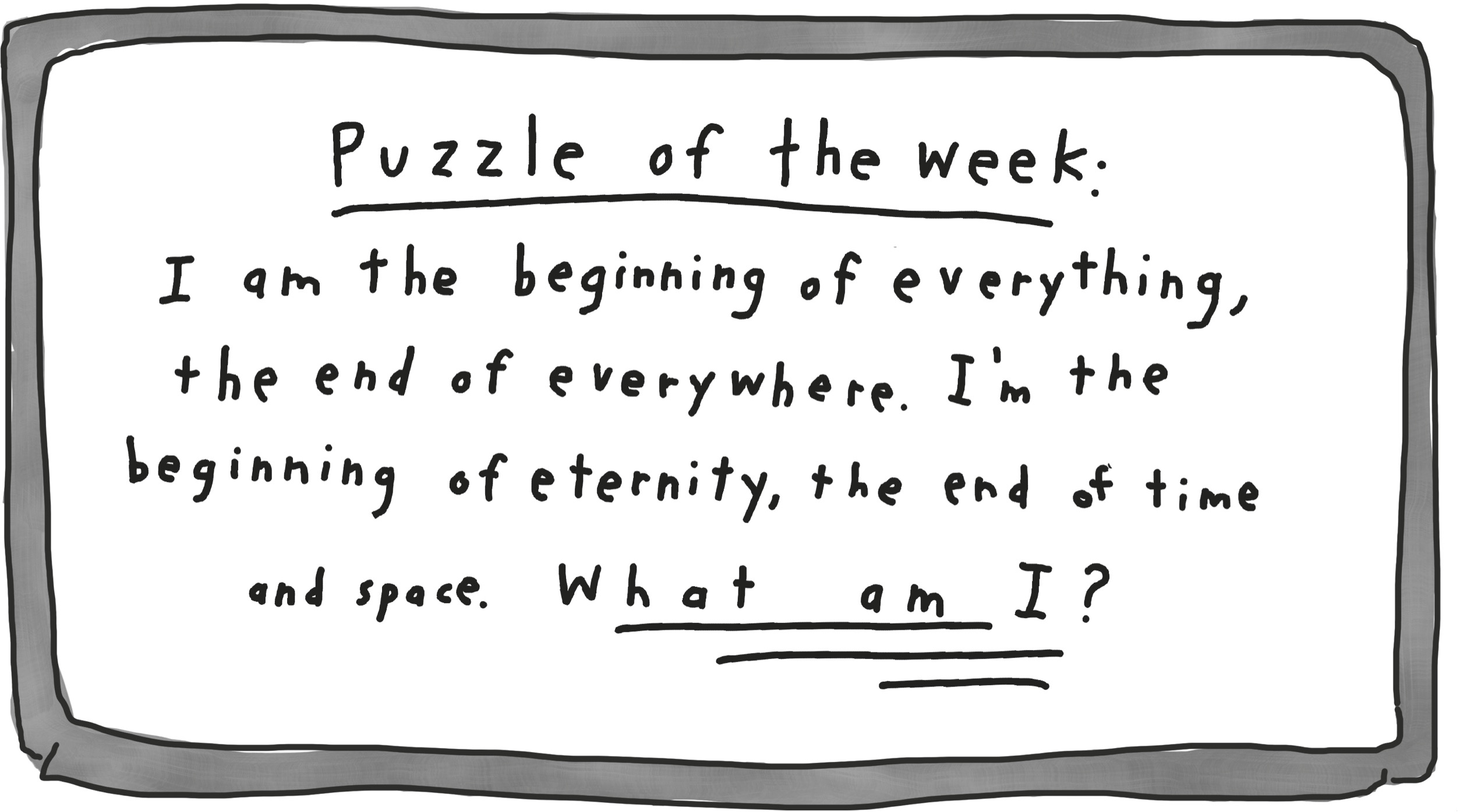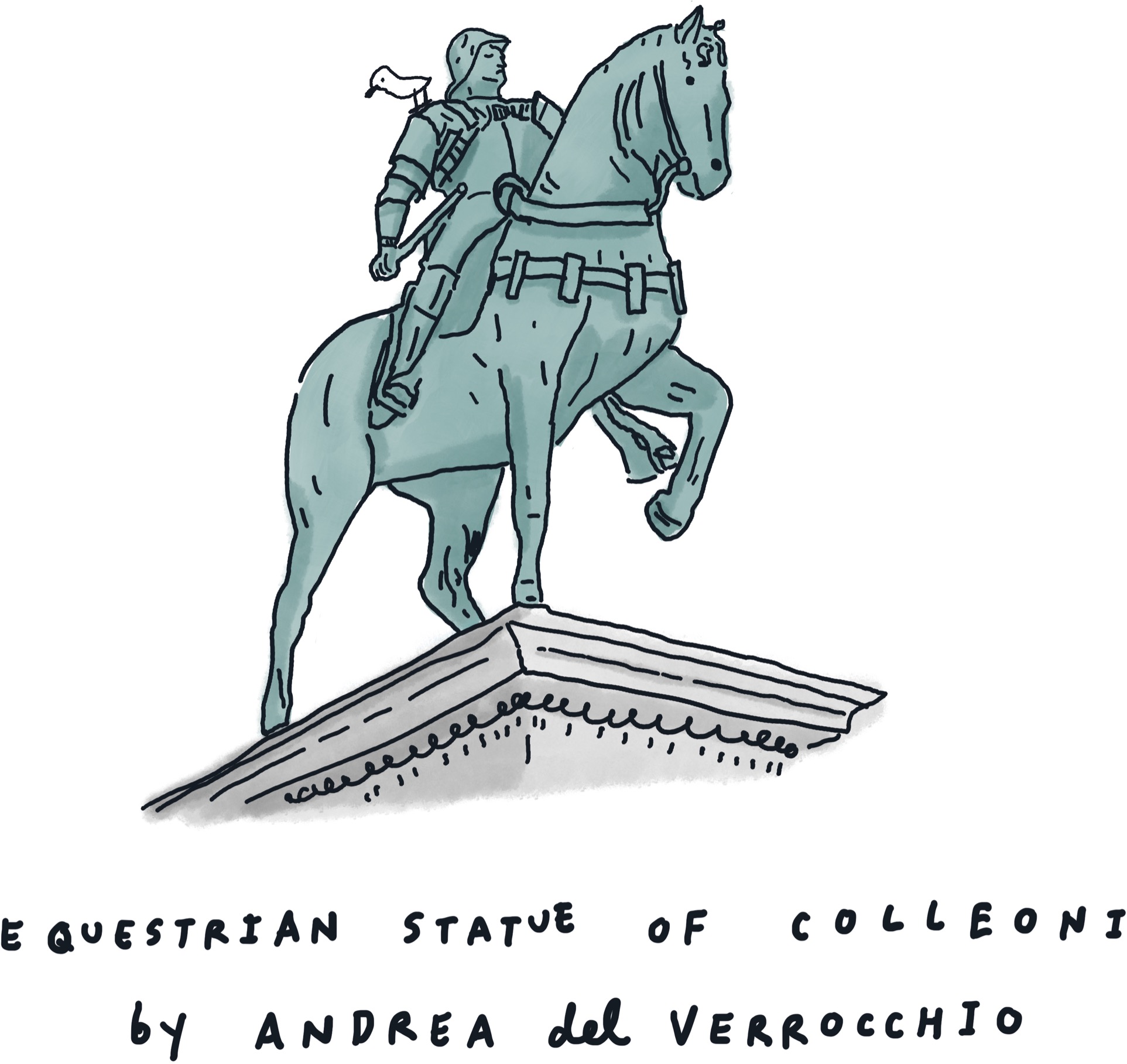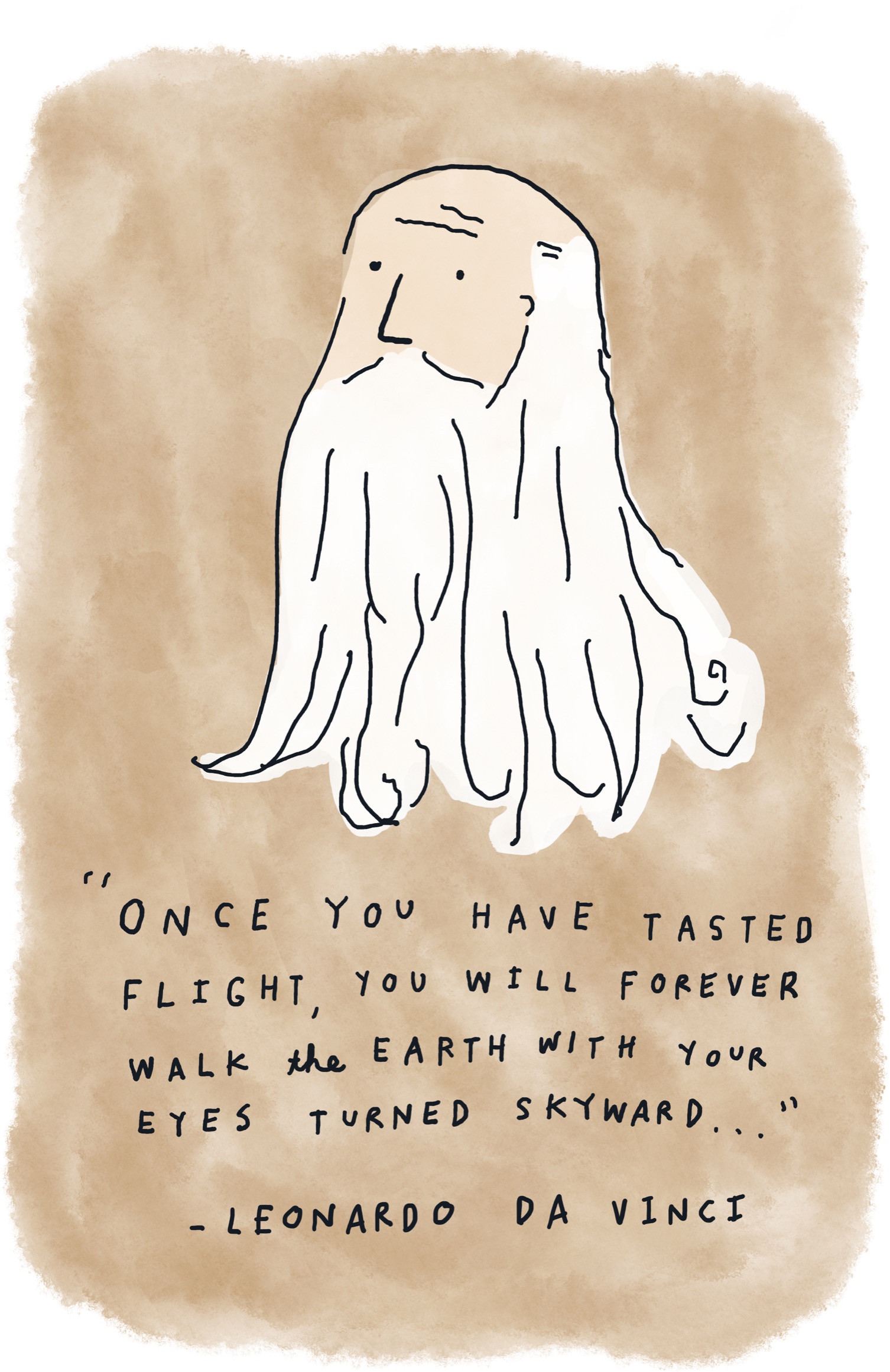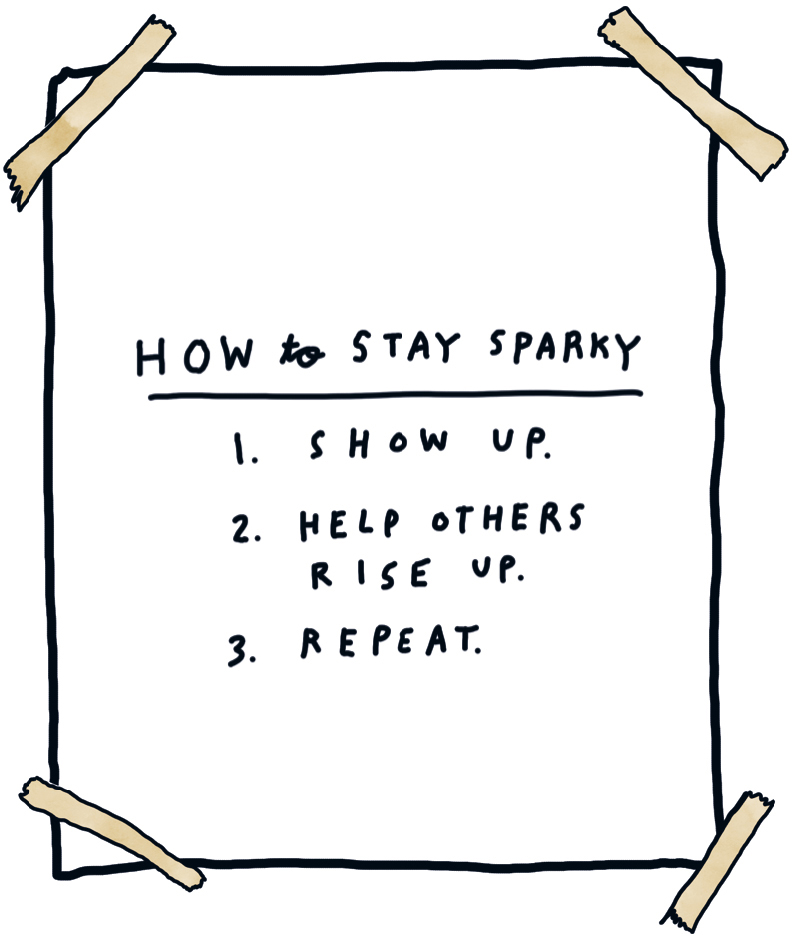It was a fairly gentle riddle, but it sparked a deep discussion. Bret Turner, of Albany, California, teaches first graders, so he’s accustomed to the unpredictable. This was different, though. One day he posted a question on the class whiteboard. It was something he’d done regularly to settle the kids down at the start of their day. Bret wrote:

“The very first guess from one of my first graders,” Bret said, “was ‘death.’” He said that an awed, somber, reflective hush fell over the class, so much so that he didn’t want to interrupt it to tell them the real answer. “The letter e seemed so banal in the moment.”
Kids don’t always provide you with what you’re looking for; instead, they often give you something better. That’s exactly what I discovered as I went from classroom to classroom. A large part of me thought the Listening Tour would be a way for me to help kids feel better. I thought they’d be encouraged to know a grownup wanted to hear what they had to say.
Instead, they made me better.
We swapped seats as teachers and students. For so long I’d been making things for children in the hope that it would encourage and inspire them. Then when I lost my way, the voices of children encouraged and inspired me. Their unassuming honesty, open generosity, and playful curiosity brought me back to the child I once was and the grownup I so desperately wanted to become.
The responses to “What does it mean to be a grownup?” were always fascinating:
“To be a grownup is to have money. They should use the money and buy kids stuff.”
“Being a grownup is someone who is tired and has tired eyes. I want to have a dog when I grow up.”
“A grownup is a person who works hard at their job and they love their family.”
“Being a grownup means to do fun things.”
“It means you are more respected by people.”
Some students wrote or drew their responses and then sent them to me. Here are a few of my favorites:

One student, Will, drew a picture of me and him “helping “somewon” with the caption “To be a grownup means to be kind.”
Another student drew a picture of a shark. Not sure why. This project definitely taught me not to question things like this. Maybe he just wanted to draw a shark, okay?

Then there’s the drawing of a student, Samuel, imagining what he’ll look like when he grows up to play in the NFL. I love what he wrote in part of his essay:
“To be a grownup means to inspire kids to make them want to be a grownup.”
I remember being terrified to ride my new bicycle. I’d had the training wheels off my bike for quite a while, but my dangling legs made known to all that I’d long outgrown it. To remedy this, my parents bought a bicycle for me that was much too big. Like, ridiculously too large for a child. One of my favorite moments of all time, though, happened when my well-meaning grandmother tried to convince me to ride it.
After telling me things like, “You’ll grow into it” and “You just need to try it,” she moved the kickstand upward with her foot. With a bit of a struggle, she climbed onto the seat. Playfully she bounced up and down and then shot me a devilish look. Without any warning, she took off down our gravel driveway and didn’t turn back.
I’ll never forget the jolt of seeing my grandmother steal my bike. She had this massive grin on her face and actually picked up quite a bit of speed. I began wondering if she would ever give it back to me. With a joyful howl, I heard her say, “This is fun!” Then the back wheel spun abruptly to the right, tossing her to the left, into rocks and mud. Facedown.

I ran toward her. My mother appeared out of nowhere to run toward her. Her merry ride had quickly turned into a disaster. We were certain she’d broken bones and one of us would have to push the button on her Life Alert necklace. Guilt hit me like a sledgehammer. She’d done this just to encourage me to ride that bike.
She lifted her face out of the mud and said, “Your turn!”
The image of her riding that bike and the giddy way she shouted, “This is fun,” is something I think about all the time. The terror I felt when she crashed. The way she then told me it was my turn to do the same.
She’s truly one of the crucial grownups I’ve had in my life.
Whether it was riding a bike or raising children, every action she took, she did so with great joy. Even when the bike came to a crashing halt or life interrupted with any one of its many other surprises, she looked at me and then I’d hear, “Your turn!” As if to say, now you do it—but do it better.
There’s a wonderful old story about a man named Andrea del Verrocchio. He was an artist and his paintings and sculptures were said to bring people to tears. His art was so lively and seemed to capture the world around in such vivid ways that people gave him a nickname. They called him “True Eyes.” It was as if he had the uncanny ability to see all things as they really were.
When Verrocchio died, people mourned. As people can sometimes do, they began to debate which of his artworks could be declared the best. Some said his masterwork had to be one of his early religious paintings. Still others said Verrocchio’s masterwork had to be one of his alluring bronze sculptures. The debate raged on.
Many said his final work was his crowning achievement. Just before he died, Verrocchio spent all his time on an equestrian statue. As he chipped away at it, there were many who thought it was foolish. They didn’t see how he’d ever be able to sculpt a horse to look as if it were in perpetual motion. To get this effect, the horse would need to be on three legs. With that one leg up in the air, the piece would be sure to fail.

Yet he did it. He solved the challenge and sculpted a horse posed yet full of spirit and energy. It was lifelike, and it was stunning. This was a major achievement. Sadly, Verrocchio died suddenly just before it was unveiled in front of an audience. The brilliant artist was not there to hear so many who said this truly was his masterwork. One critic even went so far as to say that he’d surpassed anything they’d ever thought possible in sculpture. He’d done it. He’d made his Space Jam.
A closer look reveals more, though. While he was an accomplished artist, his nickname, True Eyes, didn’t come just from his ability to create and shape beautiful art. He had a gift for seeing everything as it really was—especially people. If you were to ask Verrocchio about his masterwork, he’d probably not mention one of his early paintings or bronze sculptures or even the triumph that was his final piece. He’d probably tell you about one of his students.
Over the course of his life, Verrocchio had many apprentices who worked alongside him. These students would help him by gathering materials, sourcing paints, and building frames; and in the process, they’d discover what the life of a true artist could be. Some of the Renaissance period’s finest artists—including Lorenzo di Credi, Pietro Perugino, and Leonardo da Vinci—learned at the feet of this man. In all their work, you can see reflected the influence of their genius mentor, yet also their own fresh spins on it. Verrocchio had the pleasure of teaching them what he knew and then learning from each of them as his pupils veered into wild, new territories he never dreamed of exploring.
When Leonardo da Vinci died, many questioned what his masterwork was. Perhaps the Mona Lisa, one of the most recognized paintings in the entire world, or maybe The Last Supper. Then there were his many innovations in aviation and the understanding of human anatomy. I’d like to think, though, that Leonardo would quietly tell you about a person, or a few people. After all, he’d once known the gift of a true-eyed mentor. He’d flown and knew it was only because someone had helped him fly. Someone had seen value in him. You don’t forget that. You pass that on.
Maybe that’s the meaning behind these words attributed to Leonardo da Vinci:
“Once you have tasted flight, you will forever walk the earth with your eyes turned skyward, for there you have been, and there you will always long to return.”
My mind flashes to all the many young people I’ve met over the past few years. They’re tasting flight, and they won’t forget it. Their eyes will be forever turned skyward because they’re surrounded by loving guides. Maybe they’ll find themselves to have grown very old and yet still keep those eyes filled with radical amazement at the incredible impact we can all have on one another.
For Leonardo, it was Verrocchio. For Steve, it was his teacher Mrs. Dorothy Fisch. For Hedda, it was the committed, caring mentorship of Fred Rogers. For someone else, it’s you.

For myself, it was a priceless mixture of parents, grandparents, teachers, and camp counselors who all showed me what was essential in life. They gave me a taste of what it felt like to soar, though I did forget. Now, though, I no longer want to settle for anything less.
My time with kids and former kids brought me back to the essentials. I’d forgotten that I was born to fly and that none of us was born to fly alone. Hanging on to this truth now, I think I’m becoming a better grownup daily.
Maybe we exist as reminders to each other of what really matters. Grownups reminding children. Children reminding grownups. We are indispensable to each other’s growth. Each of our lives is a story waiting to be told, a song waiting to be sung, a spark waiting to grow into a flame. It is the privilege of a lifetime to help each other do this.
It is bedtime at our house. With toddlers, this routine is never actually routine. There are always surprises and stops and starts. That’s the way it goes with small children. It’s always unpredictable, never boring, and occasionally disgusting.
Once the pajamas are on and the teeth have been brushed, we gather close on the bed. A glow from the bedside lamp illuminates the room with just enough light to read a story. As my wife and I settle our little joy rebels into bed, I reveal that I’ve been holding a book behind my back.
In order for them to really appreciate it, I need them to know its origin. “Do you remember Matt? I’ve told you about him. He was my camp counselor when I was a kid. Now he’s my friend.”
The kids nod. They know Matt well because he sends them postcards each week. This is a small gesture, a tiny nudge, that’s a very big deal to them and to me. When I was a kid going to summer camp, this guy was my hero. I’d since turned to him for advice regularly, and he’s remained an important part of my life. One of the many great grownups who’ve illuminated my path.
“Neither of you had been born yet. I wasn’t sure what kind of daddy I could be. Yet he sent me a very special gift. This book . . .” I hold out a copy of Roald Dahl’s Danny, the Champion of the World.
Unlike many of Dahl’s other stories, there isn’t much by the way of beastly creatures or enchanted fantasy elements. Instead, the magic here is found in the relationship between the boy and his father. Though an imperfect man, he and his son journey the bumps of life together. One of my favorite features is a postscript written by Dahl at the back of the book that says:
“What a child wants—and DESERVES—is a parent who is SPARKY!”
When Matt gifted me the book, I didn’t feel like I was up to the task of being a parent at all, much less a sparky one. It seemed an impossible goal. Yet Dahl’s postscript wasn’t the only piece of parental encouragement in the book. Matt had taken the liberty of adding a few words here and there throughout the story. Little reminders to paint a picture for me of who I really was and really could be. As a camp counselor and then mentor and now friend, he’d been who I’d needed when I was younger and was now, yet again, giving me something of unspeakable value.

I begin reading chapter 1 aloud to the kids. They’re surprised to see someone has written in it. I let them know it’s part of the experience, and so we continue. The book starts with Danny saying, “My father, without the slightest doubt, was the most marvelous and exciting father any boy ever had.”

Then I show them where Matt had added to that sentence in pen: “—UNTIL NOW!”
Better grownups help us see things in ourselves that we don’t yet see.
They help us wake up and wipe the crust from our eyes. They help us find that childlike joy for living, for loving, for dancing, and for stepping (even on Legos). We discover the world anew, and also our ability to change it.
Whether the people around you are children or former children, may you always be sparky. May people see farther because of the light you shine into everyone’s paths. May you grow and help others grow. Love and help others love. Sing and help others sing.
I delight in the hope found in you and me and my children and all little humans who call this dear world home. May we grow together and never stop growing until the sky is filled with people flying and helping each other fly.

Fly and help each other fly.
I’m telling you, it’s true.
Fly and help each other fly.
It’s what we’re here to do.